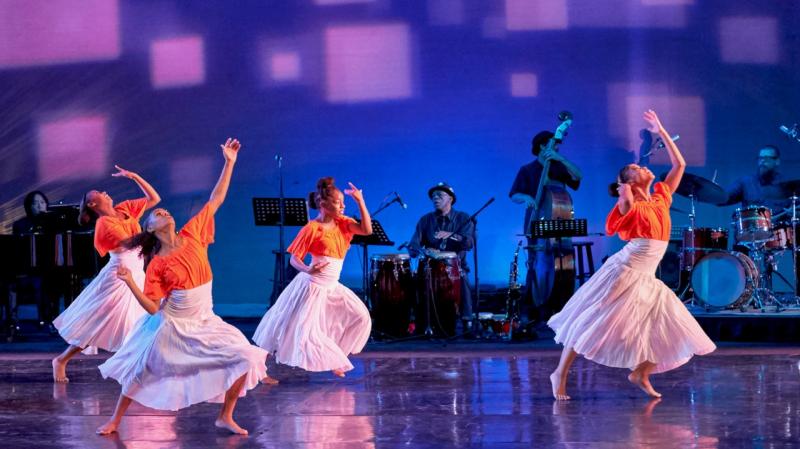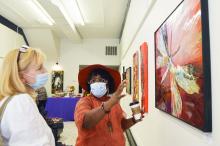ARP Grant Spotlight: JazzAntiqua

JazzAntiqua's LEGACY Teen Ensemble performing "Wade in the Water.” Photo by George Simian
Jazz has played a role in the culture of Los Angeles since the early 1920s. Following the heyday of Los Angeles’ Central Avenue, jazz music and residents expanded to the west side of town. Black-owned jazz clubs sprang up along Washington Boulevard, thriving well into the 1980s. For decades, this vibrant community’s deep roots were forgotten or simply unknown. Now, the neighborhood is reclaiming its story with the Nate Holden Performing Arts Center, a multi-use community space and home to several Black-led arts organizations.
JazzAntiqua Dance & Music Ensemble, a recent recipient of NEA American Rescue Plan funding, is one of the non-profit arts organizations that have found a home at the center. In residence for the past 12 years, the company has put on productions featuring a mix of storytelling, songs, dances, and spoken-word poetry. According to Executive Director and Founder Pat Taylor, these often-sold-out shows tie together stories across generations, languages, and lineages to offer a reflection on and reclamation of the importance of jazz and jazz dance to the Black community in Los Angeles and beyond.
“When I founded JazzAntiqua in 1993, I wanted the organization to be partially a reeducation and re-centering of the authentic roots [of jazz dance] and a remedying of what we know to be an inaccurate historical record about jazz dancing. Our mission is to… make sure that we’re true to the original West African and African American roots [of the form],” said Taylor.
As she explained, at the turn of the 20th century, Black dancers began blending traditional African steps with European styles of movement to create the jazz dance style. From dancers performing the Charleston in a Harlem nightclub to Fred Astaire and Gene Kelly performing in a Broadway musical to sequined dancers competing on stage, each of these modes of jazz dance is rooted in Black dance tradition. JazzAntiqua dancers perform in what Taylor described as a rooted jazz style, featuring full-bodied movement and performance themes that often reference the socio-political nuances of Black history in America.
“We want our audiences to see a mirror of their own experiences in the performances. It’s about creating this sense of real people sharing real stories or real experiences, and the idea that what we have learned gets passed on and whose shoulders we stand upon,” said Taylor.
Like arts organizations across the country, JazzAntiqua has been affected by the ongoing health pandemic during the past two years. Taylor and her team have worked to keep both dancers and audience members engaged, hosting performances virtually on YouTube and Vimeo, and using Facebook and Instagram Live to continue their classes and workshops. Aside from the financial challenges of lost ticket sales, Taylor says one of the most difficult parts of working virtually has been losing the energy of in-person gatherings, especially when jazz encourages an exchange of energy between the audience members and those on stage.
“In a way, the audience becomes part of the story. They have a role in how things unfold on stage, and we came up with all of these ways to keep going, but the transference of energy was greatly missed. I’m proud we were able to maintain, be creative and work together; it kept us exploring and true to our mission,” said Taylor.
In January 2022, JazzAntiqua received a $50,000 American Rescue Plan grant, which will allow the organization to support the community’s deep jazz roots through staff positions focused on coordinating community outreach and other administrative responsibilities.
In addition to performances, the company’s programs also include workshops, classes, and community engagement projects. One of the most popular community collaborations is an annual, daylong celebration of jazz dance. This jazz conference features classes, conversations, panels, and community workshops for an intergenerational audience of community members. The past years have centered around themes such as home, breath, and silence that help guide the conversations about jazz dance and tradition.
“We share the art of jazz with audiences of all ages and backgrounds and we strive to educate and inspire, as well as entertain—reminding the Black community in particular, and the greater community at large, of this rich and powerful heritage that embodies the unique African American journey to freedom,” said Taylor.
JazzAntiqua and its artists have finally been able to rehearse in person for the past several months, working on productions and an upcoming summer performance at the Massachusetts-based dance festival Jacob’s Pillow (a long-time NEA grantee). One of the most prestigious professional dance training centers in the United States, performing at Jacob’s Pillow is a bucket list opportunity for Taylor, and she is thrilled that the Jazz Antiqua is included in this honor.
“We are back at full force and looking to the future. In live music, you don’t always know what’s going to happen on stage. We are primed and accustomed to improvising and going with the flow and not getting too flustered. You are so 100 percent in that very moment and responsive to everyone and everything around you. I love it. It’s a very beautiful thing,” said Taylor.





